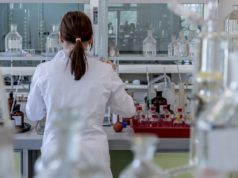GHRP-2 (Growth Hormone Releasing Peptide-2) is a synthetic hexapeptide that has garnered significant interest within the scientific community due to its potential impacts on physiological and cellular mechanisms. Characterized by its structural mimicry of endogenously occurring ghrelin, GHRP-2 is believed to interact with specific receptors to influence growth hormone secretion, metabolic activity, and immune modulation.
Although much remains to be understood, GHRP-2’s dynamic properties suggest that it may serve as a valuable tool for investigating biological systems. This article explores the theoretical and experimentally supported properties of GHRP-2, emphasizing its hypothesized implications in metabolism, tissue regeneration, and cellular signaling research.
Introduction
The field of peptide research has grown substantially over the last few decades, with a focus on small molecules that may mimic or support endogenously occurring biological processes. GHRP-2, a synthetic growth hormone secretagogue (GHS), is among the peptides of interest. Derived from modifications of met-enkephalin, GHRP-2 is theorized to function by binding to growth hormone secretagogue receptor type 1a (GHS-R1a), a receptor linked to a variety of metabolic and cellular activities.
Mechanistic Insights and Cellular Signaling
At the molecular level, GHRP-2 appears to exert its influence through GHS-R1a, a G-protein-coupled receptor that may mediate ghrelin-like signaling. GHRP-2 activation of GHS-R1a has been hypothesized to initiate a cascade of intracellular events, including calcium mobilization and cyclic AMP regulation. These signaling pathways are central to a range of biological activities, such as energy balance, appetite regulation, and cellular growth.
Hypothesized Impacts on Metabolism and Energy Homeostasis
Research indicates that GHRP-2 might modulate metabolism through its possible influence on energy expenditure and nutrient utilization. By engaging ghrelin-like pathways, the peptide may affect adipocyte activity and glucose metabolism. Studies purport that GHRP-2 might alter lipid mobilization, making it a candidate for exploring metabolic disorders and obesity-related mechanisms.
Implications in Regenerative Science and Tissue Research
The potential regenerative properties of GHRP-2 have attracted interest in tissue engineering and repair. By promoting the release of growth hormone, which is thought to stimulate cellular proliferation and differentiation, GHRP-2 may theoretically influence wound healing and tissue regeneration. Investigations into its impact on mesenchymal stem cells suggest that GHRP-2 may encourage these cells to differentiate into specific lineages, such as osteoblasts or chondrocytes.
Immune System Research
GHRP-2’s interaction with the immune system presents another promising area of research. Through its engagement with GHS-R1a, GHRP-2 is hypothesized to impact the function of immune cells, including macrophages and T lymphocytes. Preliminary data suggest that GHRP-2 might influence inflammatory cytokine production, providing a framework for investigating immune responses in various pathological contexts.
The peptide has also been theorized to impact oxidative stress pathways, which are closely linked to immune cell function and cellular resilience. By modulating redox balance, GHRP-2 may be of interest to researchers studying mechanisms of inflammation and tissue damage, particularly in chronic conditions where oxidative stress plays a pivotal role.
Neuroprotective and Cognitive Research Implications
The central nervous system (CNS) represents an emerging frontier for GHRP-2 research. It has been hypothesized that GHRP-2 may cross the blood-brain barrier, enabling it to interact with neuronal receptors directly. This interaction might shed light on mechanisms of neurogenesis and synaptic plasticity, critical processes for learning and memory.
GHRP-2’s potential role in mitigating neuronal damage has also been investigated, with some research indicating that it might reduce cellular apoptosis under stress conditions. Such properties suggest that GHRP-2 may be integrated into models of neurodegenerative disorders to explore novel pathways.
Cardiovascular Potential and Vascular Biology
GHRP-2 is thought to influence cardiovascular physiology through its possible impacts on vascular endothelial cells and smooth muscle function. Studies suggest that the peptide might promote angiogenesis, the process of forming new blood vessels, which is essential for tissue repair and organ regeneration. Additionally, its impact on vascular tone and nitric oxide signaling might provide insights into blood pressure regulation and vascular integrity.
In the context of ischemic injury, GHRP-2 has been hypothesized to support perfusion and protect against cellular hypoxia. This property may be leveraged in experimental models to study tissue survival and recovery following vascular compromise.
Future Directions and Considerations
While GHRP-2’s properties have opened up intriguing research avenues, significant questions remain regarding its mechanisms of action and broader implications. Future investigations might focus on elucidating receptor-ligand dynamics, downstream signaling pathways, and cross-talk with other physiological systems.
The development of synthetic analogs or derivatives of GHRP-2 with tailored properties may further expand its utility in biological research. By modifying its structure, scientists may potentially refine its specificity and support its potential implications in targeted studies.
Conclusion
GHRP-2 represents a versatile peptide with multifaceted impacts on biological systems. Its hypothesized roles in metabolism, tissue regeneration, immune modulation, and neuroprotection highlight its potential as a research tool for probing complex physiological processes.
As investigations into GHRP-2 continue to evolve, this peptide may help unravel critical questions about mitochondrial function and cellular dynamics. Through careful experimental design and exploration, GHRP-2 might become a cornerstone for advancing our understanding of peptide-based signaling in living systems. Researchers can buy GHRP-2 online from Biotech Peptides.
References
[i] Broglio, F., Gianotti, L., Destefanis, S., Gottero, C., Gauna, C., & Ghigo, E. (2003). Neuroendocrine and metabolic effects of ghrelin and synthetic GH secretagogues in humans: A brief overview of the current research. Growth Hormone & IGF Research, 13(Suppl A), S21–S26. https://doi.org/10.1016/S1096-6374(03)00038-3
[ii] Smith, R. G., Jiang, H., & Sun, Y. (2005). Developments in ghrelin biology and potential clinical relevance. Trends in Endocrinology & Metabolism, 16(9), 436–442. https://doi.org/10.1016/j.tem.2005.08.009
[iii] Takahashi, Y., Mönig, H., & Iguchi, G. (2006). The ghrelin/GHS-R system and its physiological roles in health and disease. Peptides, 27(6), 1387–1400. https://doi.org/10.1016/j.peptides.2005.12.014
[iv] Dong, J., & Ying, Y. (2018). Emerging roles of growth hormone-releasing peptides in tissue repair and regeneration. Current Protein & Peptide Science, 19(2), 104–113. https://doi.org/10.2174/1389203718666170814112724
[v] Xu, J., Chan, K. W., Wang, Y., & Hong, X. (2021). Role of ghrelin and its analogs in cardiovascular, neuroendocrine, and immune health. Frontiers in Endocrinology, 12, 748127. https://doi.org/10.3389/fendo.2021.748127
Auch interessant
– Krebsbehandlung –
Deutschtürkische Biontech-Gründer forschen an Krebsmedizin
Das Biontech-Gründerpaar Ugur Sahin und Özlem Türeci sieht nach seinem Erfolg mit dem Corona-Impfstoff die größeren Aufgaben noch vor sich.





































































